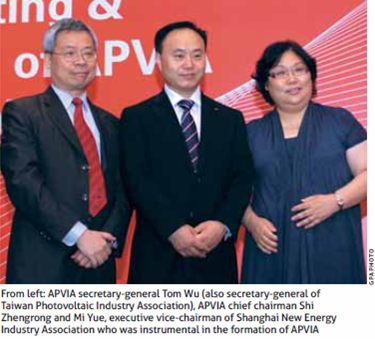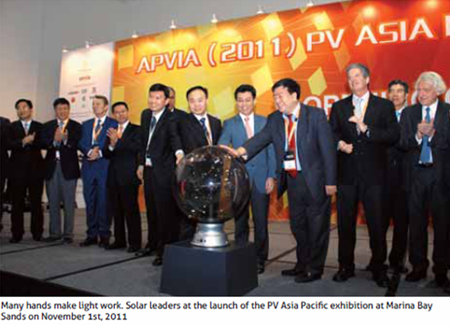
(Photo credit: GPA.com)
On 31 October 2011, the spanking new Marina Bay Sands exhibition and convention centre played host to the who's who of Asia's solar industry luminaries. They were all there for the historic first election of office bearers for the Asian PV Industry Association (APVIA).
It was no surprise that the Chinese dominated the meeting, as solar players from China have swamped the trade. Mr Shamsudin Khalid, the President of the Malaysian Photovoltaic Industry Association, and a few European and other Asian representatives were the only non-Chinese present, and they stood out in a roomful of Mandarin-speaking businessmen.
The election saw high-profile Suntech Power Holdings Co Founder and CEO Dr Shi Zhengrong being made chief chairman, and when the meeting was done, everybody posed for photos with each other. The banquet that followed the historic meeting, surprisingly, served French cuisine paired with red wine that was copiously drunk at every table. As the night wore on, the business jackets and neckties came off and sleeves were rolled up. Soon, people were deserting their seats to go around tables, offering toasts.
It was a wonderful party, but the merriment of that night belied the worries, and even panic, which have gripped industry players around the world today. Feed-in tariff (FiT) cuts or cancellations by several European countries, including Germany, the world's biggest consumer of solar energy, have landed many solar producers in serious trouble.
Stocks are piled up high in warehouses and retail prices have hit historical lows, even below cost. Excess production capacity has forced some to lay off workers. A few have had to fold up. The blame game has started, with US unit Solar World leading the charge against the Chinese for unfair competition. Counter charges have been leveled by Chinese manufacturers.
Stocks are piled up high in warehouses and retail prices have hit historical lows, even below cost. Excess production capacity has forced some to lay off workers. A few have had to fold up. The blame game has started, with US unit Solar World leading the charge against the Chinese for unfair competition. Counter charges have been levelled by Chinese manufacturers.

(Photo credit: GPA.com)
Downturn temporary
At a Solar Leaders' Summit the day after the election, Chairman Shi was understandably optimistic in his speech, describing the present scenario as a "temporary downturn". He said the market was "overheated" in the past few years and market growth failed to match investments in capacity building. "We need to hold together and hang in there to get through this difficult time."
To lift the industry, solar leaders like Dr Shi and European PV Industry Association (EPIA) Chief Murray Cameron said Asia must deliver on solar take-up. By Asia, they mean China and India--the two giants with energy demand to mop up excess capacity. Incidentally, these two countries are not exactly generous with their FiT rates. Latest bids for PV quotas in India have revealed prices that would have been unheard of last year.
Dr Shi said: "We believe by 2015, Asia will install about 20 GW per year. About a quarter of global demand will be from Asia by then. Recently, China is installing or has installed over 2 GW. India is following fast. Japan too. We see Asia being one of the major markets in the world in 2015 and beyond."
His optimism is founded on the declining cost of solar materials, with silicon now trading at US$40 per kg, or 10 percent of what it used to cost. He projects the price of solar to be about US$0.14 per kWh by 2015, a plunge from the US$1 per kWh that used to be industry's target.
"Grid parity has arrived in some countries today; it took less than 10 years," he said. By 2015, he reckons half the countries with solar plants will reach grid parity due to reduced cost of solar materials, global collaboration, and government's FiT initiatives.
EPIA's Mr Cameron, of Germany's Phoenix Solar AG, said the previous decade for solar belonged to Europe where, "rather ironically, the largest market for PV in the world is also oneof the least sunny places".
"In Germany (the world leader in solar installations), what's been happening is basically just substitution. But Asia is where you have a real need, where economies are growing, where there is enormous demand for new generation capacity. Solar PV must play that role here. This is where the next 10 years of PV destiny will be made."
Asia has not resorted to using solar energy in a significant way as it is far more expensive than electricity from fossil fuel. However, things are changing. Many Asian countries, led by China and India, are prepared to usher in solar and other renewables by introducing FiT regimes. And their timing perfectly coincides with the lowest prices in history.
Cost to drop further
Prof Martin A Green, Australian PV expert and newly-elected Co-chairman of APVIA's academic committee, said the cost of PV modules will go down by 60 percent between 2010 and 2020.
"In terms of new markets, the industry has reached an interesting stage where the cost of PV has come down very rapidly. With prices going down over the next decade, more and more places in the world will reach that stage of retail competitiveness. And by the end of the decade, you reach the other side of wholesale electricity. At the present stage, it is still quite fragile."
.jpg?sfvrsn=7d2e0879_0)
Prof Green said they expect polysilicon spot price to be "in the mid-US$30s" by 2012, with contract prices stepping down on a multi-month lag (see chart above). On top of that, he foresees cell efficiency will reach 20 percent at US$0.50 per watt production by 2020.
Mr Ahmad Hadri Haris, Senior Director of Public Affairs for thin film giant First Solar, said current manufacturers' excess capacity is between 30 and 40 percent. "What it means is that you have 30-40 percent more product inventories than what the market requires," he said.
"That's why you see some companies selling lower than cost. That is not sustainable. They are not looking at long-term business. Tier one manufacturers are in it for the long haul. For other players, they don't care for quality and just want to push prices down and penetrate markets."
Mr Hadri thinks prices have hit rock bottom. "Market correction was due to the economic crisis in 2009. Investors didn't have any more money to invest, and they cancelled projects. This year, it was due to oversupply as new players came onboard.
"If you look at the price of polysilicon, it has come down even lower than pre-2008 and is now in the region of US$40 per metric tonne. At one time, the spot price was US$400. Maybe people can squeeze it some more. But in terms of reduction, it will not be huge."
Market shifts
Some strong market trends are emerging from that drop in cost. A recent Lux Research report predicts that solar markets will shift dramatically from 2010 to 2016--Europe from over 80 percent of the market to only 43 percent, Asia Pacific from 13 percent to over 28 percent.
North America will go from 6 percent of the market in 2010 to 19 percent in 2016. The Middle East and Africa, Central and South America, and the rest-of-world segments remain small, given a lack of subsidies in big countries--though plenty of upside exists due to good sunshine and poor grid coverage.
Grand predictions aside, the Asian market is still about energy pricing. Asia's governments are cautious about putting too many apples in the cart, although there are more solar modules produced in Asia Pacific than in the rest of the world.
.jpg?sfvrsn=6e2e0879_0)
Mr Shi Dinghuani, Counselor of the State Council of China and President of Chinese Renewable Energy Society, said using solar is 10 times more costly than using coal in China. However, he said that the government has signalled intentions of buying PV power for commercial and residential purposes with the current PV target at 1.5GW.
Cost aside, the solar industry is a huge economic engine in its own right and is a job creator. Dr Shi said the Asia PV industry has seen annual growth rates of over 55 percent and it has provided huge growth opportunities. "Through innovation and economies of scale, Asia PV enterprises have dramatically reduced the cost of PV generation. We have become an economic engine in Asia. For every MW of PV installed across the world, 35 jobs are created throughout the PV industry supply chain. Of that number, 15 jobs are downstream, like project development, installation, maintenance and financing. It's very localised."

Article republished with permission from Green Purchasing Asia, a media partner of SIEW 2011. The author is the Managing Editor for GPA.
BY : David Lee, Green Purchasing Asia